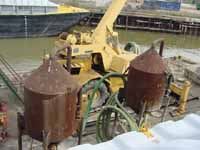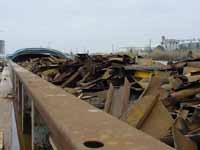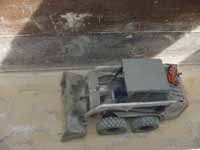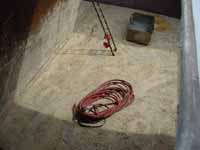Shipyard Employment eTool
Barge Cleaning Operations >> Dry Bulk Cargo Barges
Dry bulk cargo barge cleaning is the process of removing residual cargo and cleaning the spaces (such as hoppers or holds) and/or tanks on the barge in order to load a new or different cargo, inspect, or repair. Cleaning may be conducted on a barge while at a pier, in a drydock, while beached, or at anchor. The cleaning process normally includes:
Each of these steps include many of the same hazards. These hazards should be evaluated throughout the barge cleaning process.
Typical cargoes carried by dry bulk cargo barges include:
- Grain and grain products
- Coal
- Petroleum coke
- Fertilizer
- Scrap metal
- Ores
- Aggregate (rock, cement, sand, gravel)

Cleaning typically consists of:
- Mechanical (such as front-end loaders, cranes, buckets, and vacuums) or manual (such as push brooms, wheelbarrows, buckets, shovels) removal of residual cargo,
- Washing of holds and/or tanks with hoses, and
- Removal of wash water with pumps and/or siphons.
Note: Confined space entry is one of the leading hazards associated with barge cleaning. Review the Ship Repair: Confined or Enclosed Spaces and Other Dangerous Atmospheres chapter for information on how to protect workers from this hazard.



Includes securing the barge, ballasting if required, identification and confirmation of cargo.
The following safety and health information should be reviewed:
- Confined or Enclosed Spaces and Other Dangerous Atmospheres
- Hazardous material assessment
- Access to Vessels: Barges and River Towboats.
See also, Access and Guarding of Working Surfaces - Static electricity hazards
- Personal Protective Equipment (PPE)
- General working conditions
- Fire and explosion hazards
- Respiratory hazards
- Corrosive and toxic material hazards
- Excessive noise hazards
- Limited access hazards
- Slip and trip hazards
- Fall hazards
- Work environment temperature related hazards
- Electrical hazards



Includes setting up cleaning equipment, opening covers and/or manholes, visually inspecting spaces (such as hoppers or holds) from the outside, and providing adequate access.
The following safety and health information should be reviewed:
- Opening covers
- Ventilation
- Static electricity hazards
- Personal Protective Equipment (PPE)
- Inventory of Hazardous Materials
- Access to Vessels: Barges and River Towboats.
See also, Access and Guarding of Working Surfaces - Materials Handling (including Gear and equipment for Rigging)
- General Working Conditions
- Tools
- Ladders
- Respiratory hazards
- Corrosive and toxic material hazards
- Excessive noise hazards
- Limited access hazards
- Slip and trip hazards
- Fall Hazards
- Work environment temperature related hazards
- Electrical hazards
Additional Resources:
- 29 CFR 1918 Subpart E, Opening and Closing Hatches. Note: This reference is for informational purposes only and is not required in Shipyard Employment.
- 29 CFR 1918.65, Mechanically-powered vehicles used aboard vessels. Note: This reference is for informational purposes only and is not required in Shipyard Employment.
Includes mechanical and manual removal of residual cargo and washing barge cargo hold, and sampling of wash water, as required by permit. When operating equipment with internal combustion engines, it is important to maintain adequate ventilation to prevent carbon monoxide build-up.
The following safety and health information should be reviewed:
- Confined or Enclosed Spaces and Other Dangerous Atmospheres
- Personal Protective Equipment (PPE)
- Access to vessels: barges and river towboats. See also, Access and Guarding of Working Surfaces
- Inventory of Hazardous Materials
- Tools
- Ladders
- Materials Handling (including Gear and equipment for Rigging)
- General Working Conditions
- Respiratory hazards
- Corrosive and yoxic material hazards
- Excessive noise hazards
- Limited access hazards
- Slip and trip hazards
- Fall hazards
- Work environment temperature related hazards
- Electrical hazards



Includes final inspection, equipment removal, closing up the barge and de-ballasting.
The following safety and health information should be reviewed:
- Confined or Enclosed Spaces and Other Dangerous Atmospheres
- Inventory of Hazardous Materials
- Personal Protective Equipment (PPE)
- Access to vessels: barges and river towboats.
See also, Access and Guarding of Working Surfaces - Ladders
- Tools
- Materials Handling (including Gear and equipment for Rigging)
- General working conditions
- Respiratory hazards
- Corrosive and toxic material hazards
- Excessive noise hazards
- Limited access hazards
- Slip and trip hazards
- Fall hazards
- Work environment temperature related hazards
- Electrical hazards


